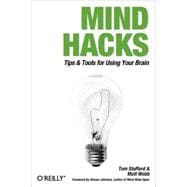
Note: Supplemental materials are not guaranteed with Rental or Used book purchases.
Purchase Benefits
What is included with this book?
Tom Stafford has a PhD in Cognitive Neuroscience and is currently a research associate in the Department of Psychology, University of Sheffield. He is also an associate editor of the Psychologist magazine and has previously worked as a freelance writer and researcher for the BBC.
Matt Webb's background is in new media. His freelance activities include an IM interface to Google, which predated the Google API and is included in O Reilly s Google Hacks. He launched a project to find the Web's favorite color that was featured on BBC News Online and national newspapers in the UK. His current job in R&D at the BBC involves these kinds of projects internally, and gives him experience at addressing abstract social and technological ideas to mixed audiences. He was a popular speaker at O Reilly's Emerging Technology Conference in 2004.
| Foreword | xi | ||||
| Credits | xiii | ||||
| Preface | xix | ||||
| Chapter 1. Inside the Brain | 1 | (31) | |||
|
2 | (3) | |||
|
5 | (1) | |||
|
6 | (1) | |||
|
7 | (1) | |||
|
8 | (1) | |||
|
9 | (4) | |||
|
13 | (3) | |||
|
16 | (3) | |||
|
19 | (3) | |||
|
22 | (2) | |||
|
24 | (3) | |||
|
27 | (5) | |||
| Chapter 2. Seeing | 32 | (79) | |||
|
32 | (6) | |||
|
38 | (4) | |||
|
42 | (4) | |||
|
46 | (4) | |||
|
50 | (2) | |||
|
52 | (3) | |||
|
55 | (2) | |||
|
57 | (5) | |||
|
62 | (4) | |||
|
66 | (6) | |||
|
72 | (4) | |||
|
76 | (4) | |||
|
80 | (3) | |||
|
83 | (3) | |||
|
86 | (4) | |||
|
90 | (3) | |||
|
93 | (2) | |||
|
95 | (6) | |||
|
101 | (5) | |||
|
106 | (2) | |||
|
108 | (3) | |||
| Chapter 3. Attention | 111 | (36) | |||
|
112 | (3) | |||
|
115 | (2) | |||
|
117 | (6) | |||
|
123 | (3) | |||
|
126 | (3) | |||
|
129 | (5) | |||
|
134 | (3) | |||
|
137 | (2) | |||
|
139 | (4) | |||
|
143 | (4) | |||
| Chapter 4. Hearing and Language | 147 | (26) | |||
|
148 | (2) | |||
|
150 | (4) | |||
|
154 | (2) | |||
|
156 | (2) | |||
|
158 | (2) | |||
|
160 | (2) | |||
|
162 | (3) | |||
|
165 | (4) | |||
|
169 | (4) | |||
| Chapter 5. Integrating | 173 | (27) | |||
|
173 | (3) | |||
|
176 | (3) | |||
|
179 | (3) | |||
|
182 | (4) | |||
|
186 | (2) | |||
|
188 | (2) | |||
|
190 | (3) | |||
|
193 | (2) | |||
|
195 | (5) | |||
| Chapter 6. Moving | 200 | (31) | |||
|
200 | (3) | |||
|
203 | (4) | |||
|
207 | (3) | |||
|
210 | (5) | |||
|
215 | (3) | |||
|
218 | (3) | |||
|
221 | (5) | |||
|
226 | (5) | |||
| Chapter 7. Reasoning | 231 | (20) | |||
|
231 | (3) | |||
|
234 | (5) | |||
|
239 | (3) | |||
|
242 | (4) | |||
|
246 | (5) | |||
| Chapter 8. Togetherness | 251 | (22) | |||
|
252 | (2) | |||
|
254 | (4) | |||
|
258 | (4) | |||
|
262 | (3) | |||
|
265 | (4) | |||
|
269 | (4) | |||
| Chapter 9. Remembering | 273 | (43) | |||
|
274 | (3) | |||
|
277 | (2) | |||
|
279 | (4) | |||
|
283 | (4) | |||
|
287 | (5) | |||
|
292 | (3) | |||
|
295 | (3) | |||
|
298 | (4) | |||
|
302 | (4) | |||
|
306 | (2) | |||
|
308 | (3) | |||
|
311 | (5) | |||
| Chapter 10. Other People | 316 | (29) | |||
|
317 | (3) | |||
|
320 | (5) | |||
|
325 | (2) | |||
|
327 | (4) | |||
|
331 | (4) | |||
|
335 | (3) | |||
|
338 | (4) | |||
|
342 | (3) | |||
| Index | 345 |
The New copy of this book will include any supplemental materials advertised. Please check the title of the book to determine if it should include any access cards, study guides, lab manuals, CDs, etc.
The Used, Rental and eBook copies of this book are not guaranteed to include any supplemental materials. Typically, only the book itself is included. This is true even if the title states it includes any access cards, study guides, lab manuals, CDs, etc.